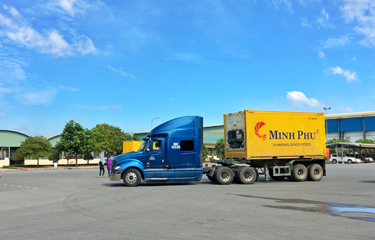Inspired by rising demand for exports, Vietnam expands its shrimp processing capacity

Buoyed by export success last year, shrimp companies in Vietnam are eager to build more processing factories to meet rising international demand for their products.
The planned expansion is mainly centered in Mekong Delta, where the Vietnamese government is pushing a broader strategy of regional development.
According to Fimex Chairman Ho Quoc Luc, numerous shrimp-farming companies are participating in the planning process.
“[It's] a sign showing a new promising period of the country’s shrimp sector, despite the COVID-19 pandemic," Luc said.
Earlier this year, Thuan Phuoc Seafoods & Trading, which is based in the central city of Da Nang, commissioned its An An factory in the Mekong Delta Province of Tien Giang. The plant cost VND 400 billion (USD 17.3 million, EUR 14.5 million), and has a capacity of 50 metric tons (MT) per day. A cold-storage facility with a 3,000 MT per year capacity was also built along with the factory. Material for the plant will be supplied from Thuan Phuoc’s farms of 200 hectares in the nearby province of Ben Tre.
The addition of the An An factory will help Thuan Phuoc become one of the leading five shrimp companies in Vietnam, Luc said.
Another company from the central region, Nha Trang Seafood from Nha Trang City, also established its presence in Mekong Delta by constructing a new shrimp processing facility in Bac Lieu Province. Work on the plant, which will have a 10,000 MT annual capacity once complete, is going to be finished soon, Luc said.
Two other producers, Sea Minh Hai and Ca Mau Seafood Processing and Services, have already upgraded their existing factories and cold-storage facilities in Bac Lieu and Ca Mau, respectively.
For his own company, Luc told SeafoodSource that Fimex is proceeding with the construction of two new processing plants in Soc Trang Province, one with a capacity of 15,000 MT per year and the other with 10,000 MT annual capacity.
Minh Phu Seafood also has plans to strengthen its positiong as Vietnam’s leading shrimp export company by constructing a number of new processing plants in the region, the company’s CEO, Le Van Quang told SeafoodSource.
The first of the two plants the the company will build this year is the Minh Phat plant, which will have an annual capacity of 30,000 MT of finished products. Minh Phu hopes to begin work on the project in Ca Mau in May 2021, and construction is expected to take one year. The company estimates the new factory’s cost at VND 1 trillion (USD 43.3 million, EUR 35.7 million).
The second new factory from Minh Phu will be located in Hau Giang Province and will have an annual capacity of 15,000 MT of breaded shrimp products.
In 2023, Minh Phu will build a third plant, named the Minh Qui plant, in Ca Mau with a capacity of 20,000 MT per year, which will be raised to 30,000 MT per year after one year of operation.
The company also plans to construct additional factories in Kien Giang Province to process shrimp material from its own farms, which it is heavily investing in. But Quang said the company has not come up with any specific construction plan, as it is seeking approval from the local government for its land use proposal.
The Vietnamese shrimp companies’ processing expansion plans are mostly being undertaken in Mekong Delta, which is the most important shrimp-farming region in Vietnam, but has also been among the hardest hit by climate change.
Last week, the Vietnam government held a conference to review a resolution it issued in November 2017 on climate resiliency and sustainable development in the Mekong Delta. The review highlights the importance of seafood and rice farming and the need to invest more in the region’s infrastructure projects to help the region advance economically. Notably, development of the seafood sector has become the first and foremost priority of the regional government's economic initiatives, along with development of the rice and fruit sectors, according to a government statement issued on 13 March.
Between 2016 and 2020, the government has invested VND 220 trillion (USD 9.5 billion, EUR 8 billion) in the Mekong Delta, which will be increased to VND 266 trillion (USD 11.5 billion, EUR 9.7 billion) over through 2025 to develop transport, agriculture, and fisheries projects.
Last year, there were 680,848 hectares of shrimp farms in the Mekong Delta, including 597,465 hectares of black tiger shrimp and 83,383 hectares of vannamei. The region produced 782,670 MT of shrimp in 2020, accounting for nearly 87 percent of the country’s shrimp output. The total output was comprised of 271,291 MT of black tiger shrimp and 511,379 MT of vannamei, local media reported this month.
Vietnam exported shrimp worth USD 3.73 billion (EUR 3.12 billion) last year, up 11 percent compared to 2019, as sales to some major markets saw significant growth. Fimex’s Luc said in a statement on 26 January that the COVID-19 pandemic disrupted supply chains in many affected countries such as India, Indonesia, and Ecuador, creating opportunities for exporters from Vietnam to increase sales abroad.
Photo courtesy of Minh Phu






Share